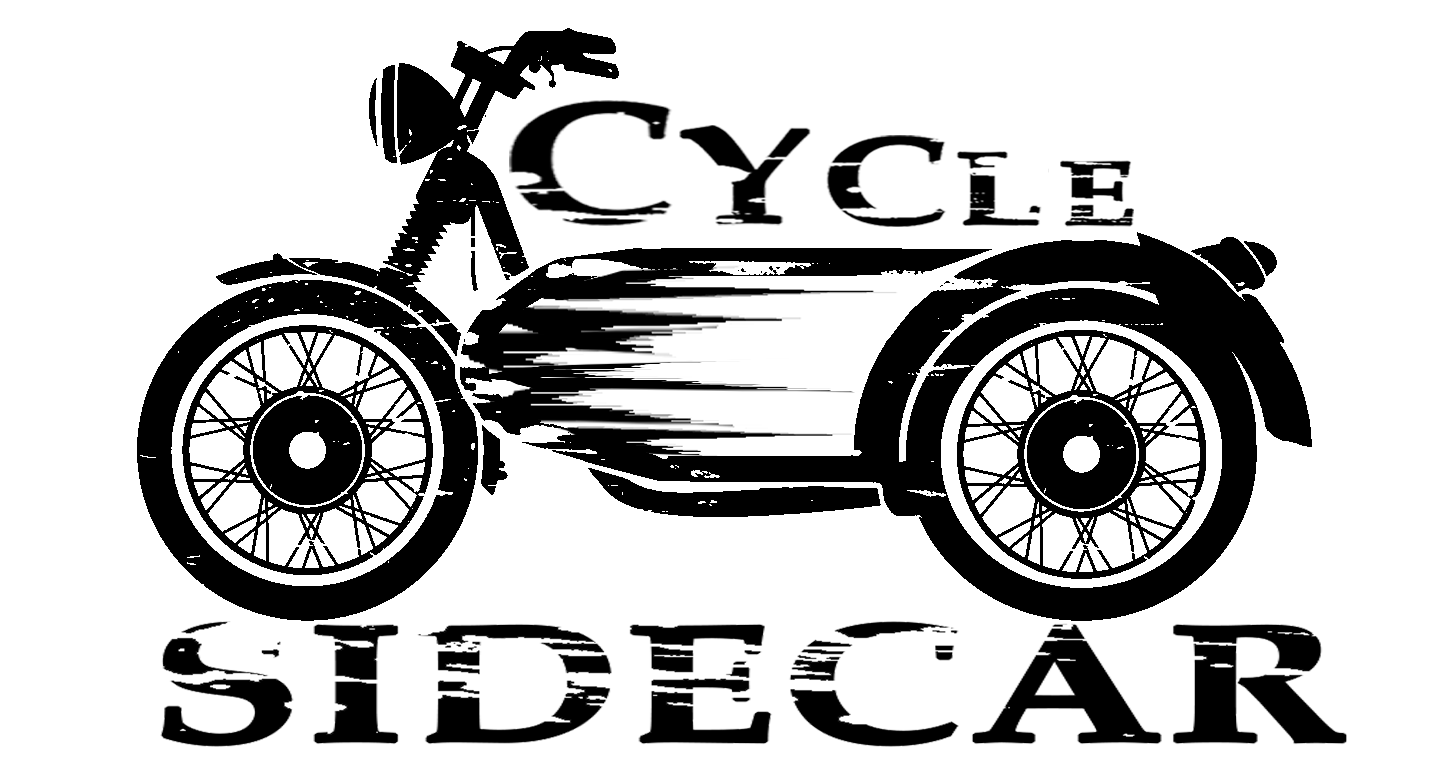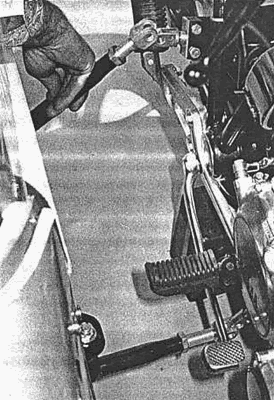Attach your sidecar using a Universal Mount:
Getting Started
The Universal Mounting Kit makes it possible to attach the sidecar to virtually any current motorcycle with round tube frame, but the motorcycle should be powerful enough to accept the weight of the sidecar, passenger, and extra luggage.
IMPORTANT: Deviating from the instructions may create dangerous conditions. It is important to follow the directions carefully, be thorough and use common sense. Each sidecar operator is responsible for his/her own safety and the safety of their passengers. For best results, we recommend soliciting installation service from a qualified dealer in your area.
Installation is a 4-5 hour process, involving these simple operations:
Attaching the frame of the sidecar to the frame of the motorcycle.
Adjusting toe-in and lean-out of the motorcycle in relation to the sidecar.
Connecting the electrical wires from the sidecar to the electrical circuits of the motorcycle.
These operations are given in easy-to-understand step-by-step procedures, which require no special tools other than regular shop wrenches, several wooden blocks or bricks for propping up the sidecar and the motorcycle, two straight strips of wood for toe-in measurements, and an angle bracket for measuring lean-out.
Note: For BMW models a special mounting bracket may be needed.
Working in a clear area, prop up the frame of the sidecar with blocks of wood or bricks to hold it level. Open the packaging of the Universal Mounting Kit and check all parts against those shown in Figure 1.
Attachment Kit - Struts, U-Clamps, Sliding Clamp, Shims, Cotter Pins (Bolts and Nuts shown fitted to assemblies)
For safety reasons and for best performance and riding comfort the sidecar should be attached to the motorcycle and all adjustments made in accordance with the instructions given in this guide.
Before proceeding, layout the Universal Mounting Kit and remove the Nuts, Bolts, and Lockwashers from the four U-Clamps, then remove tIle Spacer Block from Inside each U-Clamp. On the Strut assemblies, remove the Bolts from the Eyebolts. Have two long straight strips of wood about eight feet long (such as 2x4's), and an angle bracket, at hand for toe-in and lean-out measurements later.
Attaching Your Sidecar to Your Motorcycle
Figure 2 indicates the four attachment points on the motorcycle to which the U-Clamps must be fastened. The four U-Clamps are identical and consist of the U-Clamp, Spacer Block, Bolts, Lockwashers, and Nuts. Large and small Shims are provided for use on frame tubes which are too thin for the U-Clamps. To attach the U-Clamps to the motorcycle frame, proceed as follows:
Fit the U-Clamp to the top front of the motorcycle frame, insert the Spacer Block, and fasten in place with the two Bolts, Lockwashers, and Nuts.
Thread the Eyebolt through the Spacer Block and tighten it against the frame tube. If the frame tube is too thin for a firm grip, insert the Large Shim ahead of the Eyebolt. If the U-Clamp is still too loose, insert the Small Shim at the rear. See figure 3. Tighten the Eyebolt firmly to hold the U-Clamp in place.
Fasten the other three U-Clamps similarly to their attachment points as indicated in figure 2. It is important to fit the top U-Clamps as high as possible on the motorcycle frame, and the bottom U-Clamps as low as possible.
Note The front bottom U-Clamp may have to be attached to the cross member of the motorcycle frame in certain cases. See figure 4.
Clevis Adjusting Bolts must line up with Eyebolts. Note bottom front U-Clamp attached to cross tube of frame.
IMPORTANT: Before attaching any U-Clamp, make sure it is not obstructing any operating control on the motorcycle, such as levers, rods, switches, and not rubbing against any wire.
The Curved Bar and the Sliding Clamp are attached to the sidecar frame as follows:
First loosen the two holding bolts which are fitted to the front end of the sidecar frame, then insert the Curved Bar into the frame. Do not tighten the two holding bolts at this time. Note that the Curved Bar can be swung in an arc to simplify later assembly when connecting the Eyebolt of the U-Clamp to the Clevis Adjusting Bolt of the Curved Bar. In figure 4 one of the two holding bolts on the sidecar frame is visible, as well as the two Locknuts on the Clevis Adjusting Bolt.
Attach the Sliding Clamp to the rear part of the sidecar frame with Bolts, Lockwashers, and Nuts. Tighten the Bolts only enough to hold the Sliding Clamp in place at this time.
Insert the Eyebolt with the Spacer Sleeve into the Sliding Clamp, and fasten with Nut, as shown in figure 5. Figure 6 shows the Eyebolt and Strut inverted for cases when such an assembly is required.
First remove the bottom Nuts from the Eyebolts on the two long Struts, then insert the Eyebolts into the front and rear holes provided on the sidecar frame, as shown in figure 7. At this time reattach the Nuts to the Eyebolts loosely. Note Do not insert any Cotter Pins at this time, as the bolts will have to be tightened securely after toe-in and lean-out adjustments have been completed.
Set the motorcycle on level ground on its wheels so it stands upright. This can be done with wooden blocks or bricks placed under the frame. Position the sidecar at the right-hand side of the motorcycle so that the distance from the motorcycle frame edge to the sidecar frame edge does not exceed 1-2 inches. Prop up the sidecar frame to hold it level.
IMPORTANT: In final assembly, the short Strut at the bottom rear of the sidecar frame must be at an exact right angle (90°) to the sidecar and motorcycle frames, thus placing the sidecar wheel ahead of the rear wheel of the motorcycle by 8 to 10 inches. This wheel offset distance is important (see figure 13).
Fit the Clevis Adjusting Bolts of the Struts and of the Curved Bar to the Eyebolts of each U-Clamp, and insert the Bolts to hold the Struts in place. See figures 8 and 9. During alignment operations these Bolts must be removed to allow the Clevis Adjusting Bolt to be turned in or out, as necessary. The Locknuts on all Clevis Adjusting Bolts are left loose at this time, but will be tightened securely after Toe-in and lean-out adjustments are completed.
IMPORTANT: The long Struts connected to the top U-Clamps on the motorcycle frame must not be parallel to each other. When viewed from the top, the Struts must be angled outward from the sidecar frame to the motorcycle frame, as shown in figure 10. This angling of the Struts provides stability and lessens stress on the motorcycle and sidecar. From the standpoint of safety, each Clevis Adjusting Bolt must be threaded into its Strut at least two inches deep.
With all Struts connected, remove the supports from under the sidecar and motorcycle.
Toe-in and Lean-out Adjustments
When riding a motorcycle with a sidecar attached, stability and control depend on proper Toe-in alignment of the wheels in relation to the line of travel, and the correct amount of Lean-out of the motorcycle from the exact vertical.
Under certain conditions it may be advisable to have your dealer stiffen the front and rear suspension of your motorcycle by installing air pressure cups or other devices, and inserting cotter pins into the wheel axles (or using axle locknuts).
Toe-in adjustment is as follows:
Place one of the long straight strips of wood against the outside edges of both motorcycle tires, with the front wheel facing straight ahead. Place the other strip of wood against the outside edges of the sidecar tire. See figure 11.
Measure the distance between the wood edges at the front and rear. For accuracy and consistency, take the measurements at one foot ahead of the front wheel, and one foot behind the rear wheel. Toe-in difference at the front must be between a 1/2 inch to 3/4 of an inch less than at the rear. See figure 11. If the distance difference at the front is greater, turn the front top and bottom Clevis Adjusting Bolts clockwise (tightening). Note The top and bottom Clevis Adjusting Bolts at the rear may have to be loosened (or tightened, as the need may be) in order to achieve proper toe-in. Counter-clockwise turning of the Clevis Adjusting Bolts reduces toe-in.
Take Toe-in measurement about one foot ahead of the front tire. Distance must be between 1/2 inch to 3/4 inches less than at rear.
Lean-out adjustment is as follows:
Place an angle bracket against the outside edges of the front wheel tire, as shown in figure 12. Note the clearance between the tire and the angle bracket at the ground surface. The correct lean-out distance is 1/8 of an inch.
Note clearance between tire and angle bracket at ground surface. Lean-out, with empty sidecar, is 1/8 of an inch.
If the lean-out is not correct, remove the Nuts and Bolts from the Clevis Adjusting Bolts at the upper ends of the front and rear Struts, then turn the Clevis Adjusting Bolts inward to lessen lean-out, and outward to increase lean-out.
After making all adjustments, replace the Bolts and Nuts into the Clevis Adjusting Bolts, tighten securely, and insert all Cotter Pins.
Test ride the machine, with a passenger in the sidecar. Note that the weight of a passenger in the sidecar brings the lean-out adjustment back to zero, which is correct. For this reason it is suggested that when riding solo an appropriate weight should be carried in the sidecar for better stability. Ride the machine a short distance in a straight line and also in circles to both sides. From the standpoint of safety, bear in mind that when turning to the right centrifugal force will tend to lift the sidecar wheel off the ground. At fast speed this is dangerous! After the test ride, check the Toe-in and Lean-out adjustments, and if necessary make minor changes. Thereafter, check these adjustments after every 500 miles of travel. Whenever strong vibrations or shaking are noticed, it means the Toe-in adjustment is out of line.
Correct wheel offset shows sidecar wheel axle 8 to 10 inches ahead of motorcycle wheel axle.
Normal riding stresses and vibrations may loosen the bolts and nuts. Check all attachment points periodically to ensure that nothing has loosened!
The sidecar Wheel Offset, Fittings, and Brake must be checked periodically:
Refer to Section B for information regarding adjustments. See figures 11, 12, 13, 14 and 15.
If the sidecar wheel must be removed, the fittings come off as shown in figure 14 (Cotter Pin not shown). Replace in same order, and insert Cotter Pin.
The hydraulic Shock Absorber and Coil Spring, mounted on the Swingarm, are shown in figure 15.
A. Frame-to-Frame distance 12 inches, B. Wheel Offset 8 to 10 inches, C. Toe-in less than at D. by 1/2 to 3/4 inch, E. Lean-out 1/8 inch.
623-512-0377
Please give us a call with any of your sidecar questions.
















